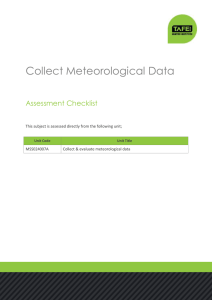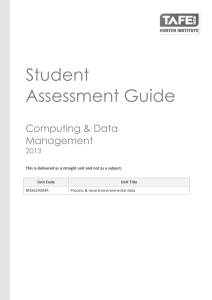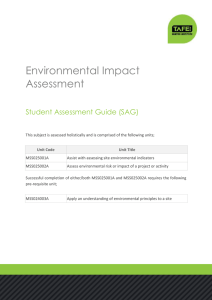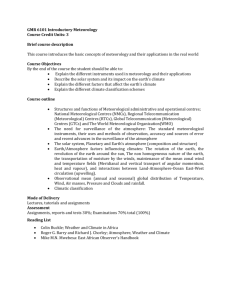Collect meteorological data Student Assessment Guide (SAG)
advertisement
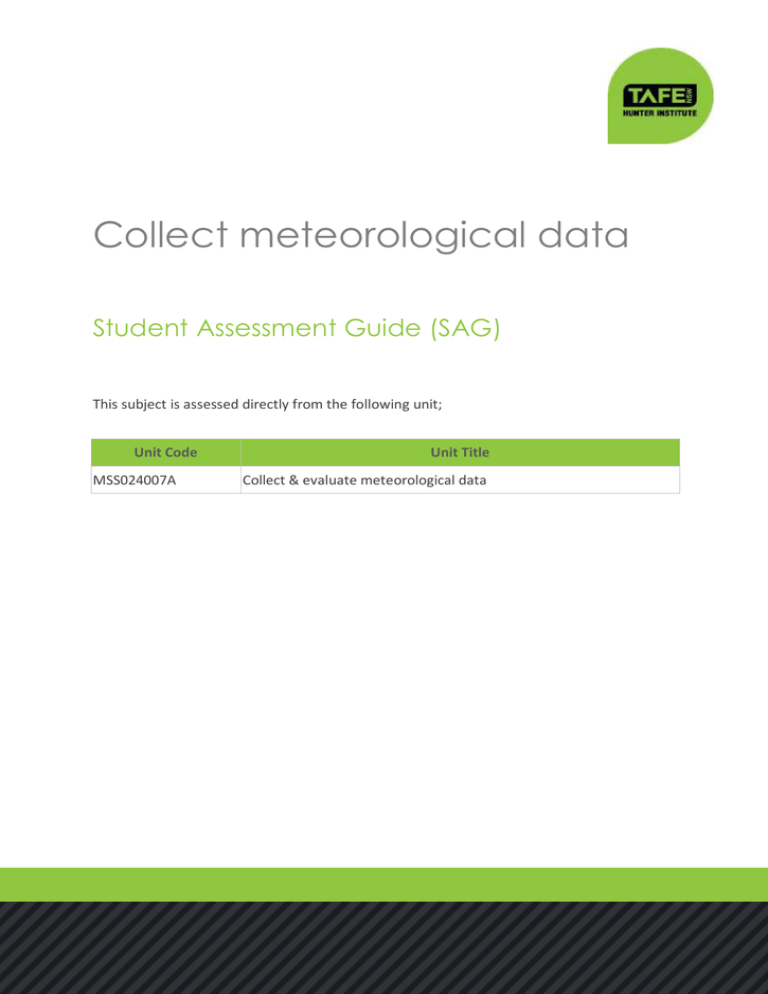
Collect meteorological data Student Assessment Guide (SAG) This subject is assessed directly from the following unit; Unit Code MSS024007A Unit Title Collect & evaluate meteorological data Collect meteorological data SAG Subject purpose This subject covers the ability to site and set up basic ‘ground level’ meteorological equipment and collect and record reliable data. It also includes the ability to assess data quality, interpret significant data features and use the data to ensure the validity of air and noise monitoring measurements Assessment Assessment for this subject will consist of a variety of skill and knowledge based evidence constructed from specific tasks spread out throughout the unit’s duration that will include the following items; • Formative assessments (skill based) • Calculations spreadsheet with data interpretation report • Set-up a portable met station with written procedure • Theory exam The assessment weighting for each component will be as follows; Assessment Task Weighting Theory / Study modules 35% Standard Operating Procedure (SOP) 10% Practical assessment (setting up met station) 25% Data collection & treatment 15% Analytical Report 15% TOTAL 100% Subject content This subject deals with setting up a portable (or stationary) meteorological station, including the following aspects; • Preparing for field work and field safety • Performing meteorological measurements • Data analysis & interpretation • Reporting of results Chemical, Forensic, Food & Environmental Technology [cffet.net/env] Version 2.0 1/03/2014 Page | 1 Collect meteorological data • SAG Learning the basic science behind meteorology and measurements including; o the need for meteorological measurements o the physics of energy and atmospheric spectroscopy o physical and chemical composition of the atmosphere o horizontal and vertical movement of air o measurement science These aspects will be performed using the following tools; • Learner resource • Spreadsheets • Portable met station • Internet access to meteorological websites Grading Your results will be reported as DISTINCTION, CREDIT, PASS or FAIL. To receive a particular grade you must get at least the mark shown below: Your results will be reported as DISTINCTION, CREDIT, PASS (AC) or FAIL (NYC). To receive a particular grade you must get at least the mark shown below: Grade Class mark DISTINCTION >=83 CREDIT >=70 PASS (ACHIEVED COMPETENCY) >=50 FAIL (NOT YET COMPETENT) <50 Delivery strategy This subject is assessed directly against the unit’s performance criteria. Unit MSL974007A Elements Performance Criteria Subject Weighting Unit Weighting All All 100% 100% NOTE: The subject weighting MUST add up to 100 for the subject, but the Unit Weighting MAY NOT add up to 100 as each unit is weighted differently in each subject it is used in. Refer to cffet.net/env/assessment for further explanation. Chemical, Forensic, Food & Environmental Technology [cffet.net/env] Version 2.0 1/03/2014 Page | 2 Collect meteorological data SAG What you will need To complete this subject successfully you will need; • Computer with internet access and spreadsheet software & email • Flash drive • Manuals for the met station • Learner resource Where to get help Contact your teacher [www.cffet.net/env/contacts] if you run into any trouble this unit. You would be surprised how flexible we are at accommodating your needs, but communication is key. If you don’t let us know you are having trouble, we may have trouble trying to help you. Resources and references Resources • Bureau of Meteorology (bom.gov.au) • Davis Vantage 2 Pro console manual • Davis Vantage 2 Pro sensor manual • MetExplore spreadsheet • AS2923-1987-Measurement of horizontal wind for air quality applications • NEPM (Ambient Air Quality) Technical Paper No. 6 References Note that you are not required to purchase, download or read these references (unless specifically directed to by your teacher). Some of these resources might be available from your teacher or library for free. (NSW), E. P. (2000). NSW Industrial Noise Policy. Sydney: Environmental Protection Authority (NSW). Ahrens, C. D. (2000). Essentials of Meteorology: An Invitation to the Atmosphere. 4th Ed. USA: Cengage, Brooks-Cole. Billo, J. (2011). Excel for Chemists, 3rd Ed. Hoboken: Wiley. Brock, F. V. (2001). Meteorological Measurement Systems. New York: Oxford University press. Burden, F. E. (2002). Environmental Monitoring Handbook. McGraw-Hill Professional. El-Rabbany, A. (2002). Introduction to GPS: The Global Positioning System. London: Artech House. Hughes, P. E. (2011). Introduction to Health and Safety at Work: The Handbook for the NEBOSH National General Certificate, 5th Ed. Massachusetts: ButterworthHeinemann. Chemical, Forensic, Food & Environmental Technology [cffet.net/env] Version 2.0 1/03/2014 Page | 3 Collect meteorological data SAG Kester, W. (2004). Analogue-Digital Conversion. United States: Analogue Devices. Manahan, S. (2000). Environmental Chemistry. Boca Raton: Lewis Publishers. Manly, B. (2009). Statistics for environmental science and management. Boca Raton: Taylor & Francis Group. NSW-EPA. (2012). Requirements for publishing pollution monitoring data. Sydney: Environmental Protection Authority. Sturman, A. E. (2000). The weather and climate of Australia and New Zealand. Melbourne: Oxford University Press. Turco, R. P. (1997). Earth Under Siege: From Air Pollution to Global Change. Oxford: Oxford University press. vanLoon, G. W. (2011). Environmental Chemistry: a global perspective. New York: Oxford University Press. Workplace Health and Safety Act 2011. (n.d.). Workplace Health and Safety Regulation 2011. (n.d.). Resources • Australian Standards can be found here (TAFE Login required) • Information related to meteorology monitoring is found here Assessment Submission Submission Students are to submit all assessments by the due date to the subject teacher by email using the following filename format; firstname-surname-assessmentname-duedate Visit cffet.net/env/assessment for more information on submitting assessments, file names and available file extensions that you can use. More about assessment You can access more information about assessment from the following two sites; • http://www.tafensw.edu.au/courses/about/assessment_guide.htm • http://www.cffet.net/env/assessment Chemical, Forensic, Food & Environmental Technology [cffet.net/env] Version 2.0 1/03/2014 Page | 4
